4/16/2014. More maintenance: swapped the CFW-8a for a CFW-10 and put a "clear" filter in the number 2 slot (the Baader FC-1 "focusing" filter differs from the "luminance" filter in not blocking IR and UV light within the CCD's available spectrum; it should mean more useful flux for all-reflective systems like the R-C and more flux, probably too unfocussed to be useful, for imperfectly achromatic refractive systems). Scroll down to tomorrow's notes for a graphical illustration and measurement of the expected advantage.
Eventually, I'll add O-III and S-II filters (for line-emission tricolor imaging). There'll still be a few slots left for experimental and rarely-needed filters (near IR, etc). I took care to change the filter wheel quickly (it took six minutes, four fewer than the ten minutes SBIG recommends; during that process, the CCD chamber was open for less than 30 seconds; the rest of the time was spent torquing the screws to final tightness). The aim of such haste is to minimize moisture absorption within the CCD chamber, and four hours on, so far, so good; the CCD remains frost-free at -30°C.
I'm verifying the order of the filters in evening light and will shoot some familiar targets to provide a baseline for the alternate luminance-channel filters. This wheel is controlled via a different port on the camera, and control seems both more responsive and less buggy than with the CFW-8a. It is considerably heavier, however, so the augmented elastic support for the camera is more important than ever. I've retired the rubber bands in favor of a loop of bungee cord. There is no protruding motor cover on the CFW-10, so all orientations of the camera are available without interference with the focussing hardware. The mated camera and wheel still fits neatly into the Pelican case I've been using for dry, air-tight storage. All in all, it's a nice upgrade. I may need to increase the spacing used with the A-P CCD67 telecompressor to keep the widest possible field, but I've no doubt the telecompessed camera will focus as is, though at a slightly longer EFL.
So, which filter should I use for base, panchromatic exposures through the AT10RC? L or Clear?
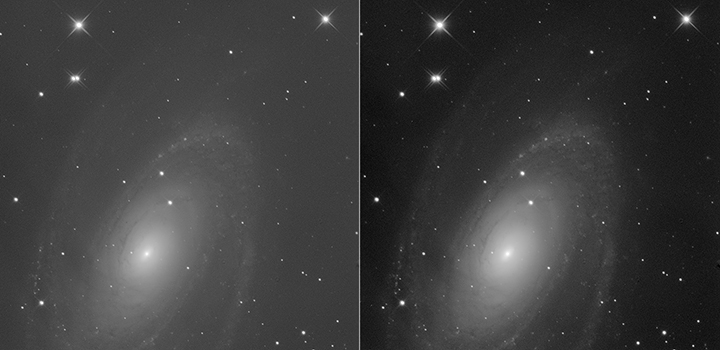
| L-filter |
M81 through two filters
(oops, probably reversed; see below)
|
Clear filter |
I did sigma combines of 13 300-second subrames taken alternately (C then L, C then L, etc) and opened them with identical histogram limits (0 - 64000), pasted the two images into a single TIFF, and processed the combined frame to insure that both were treated alike.
Then I tried it again with M51 and things got murky, and not just because the nearly full Moon was rising higher and the sky hazing over just a little. [IT'S BECAUSE YOU DID SOMETHING IN THE FILTER DIALOG INCORRECTLY, Doofus! Keep reading.]
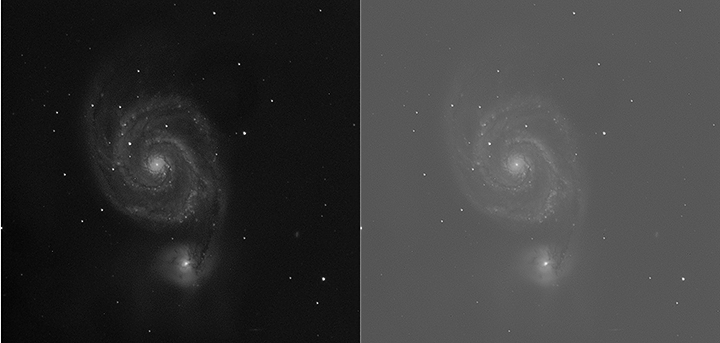
| L-filter |
M51 through two filters
|
Clear filter |
Same part of the sky, processed identically (as above with M81), 12 pairs of 300s subs, but this time the L frame looks better "out of the can" than the C frame -- which is not to say it's the better image after each is processed seperately.
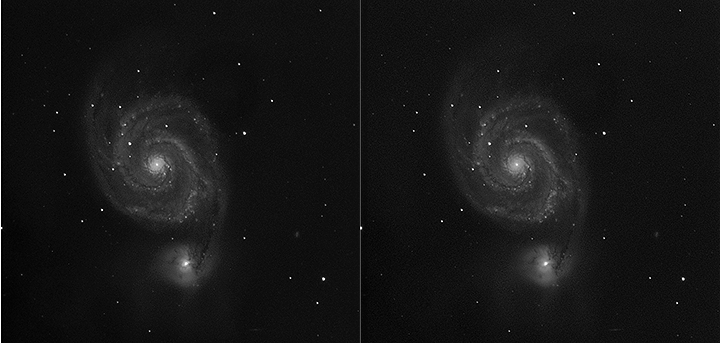
| L-filter |
M51 through two filters
|
Clear filter |
I'm thinking that after a minor range adjustment, the C-filter is (sliightly) better on M51 and I see little if any difference between the individually adjusted results for M81 (not shown). So I think the C-filter is the way to go with the Ritchey, in keeping with theory, but it's not as obvious in the data as I had hoped.
Test this again -- the M51 imagery is so perfectly the reverse of M81's that the comparison needs to be repeated. Take care to use the very same autosave dialog, changing only the name of the target. [YEP. That made a difference, scroll on down.] I think that setting the filters by wheel position is accomplished under the "Filter Wheel" setup with the camera disconnected and that specifying filter names in the autosave dialog suffices to select the correct filter. Could be wrong... [Well, I was wrong somewhere, anyway.]
Since I have the data, here's the sum of all the C and L subs for M51.
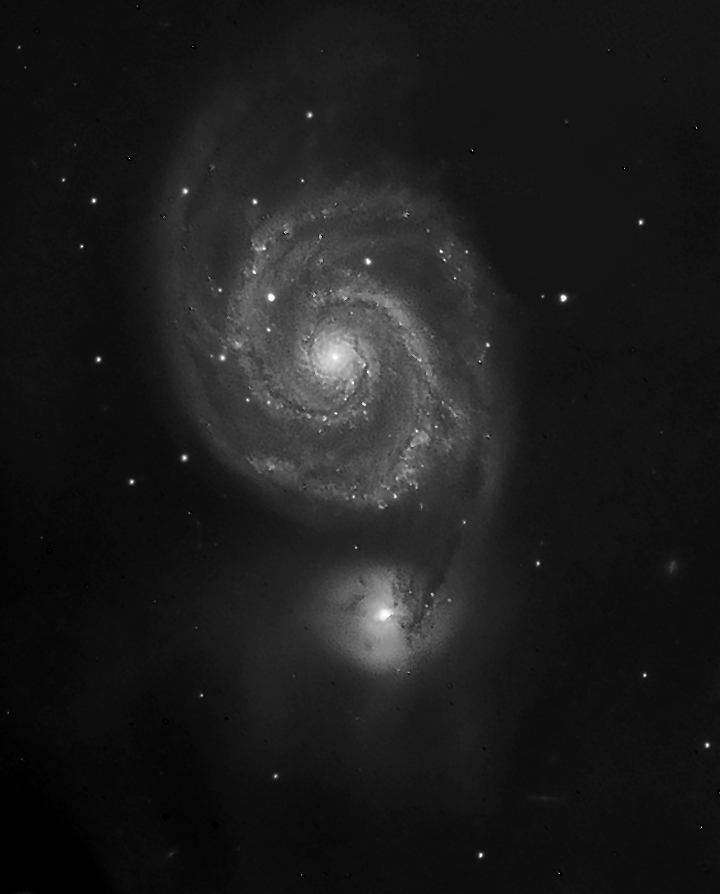
M51
12 x 300s C + 12 x 300s L
2 hours total
Not bad for full moonlight, eh? Could use a better flat (or a blast of compressed air) to remove two big dust donuts, shadows cast by junk in the optical path.
4/17/2014. Try that again, this time taking care to use the same preset for both targets. Same method, same displays, images using L and clear filters, unpacked from FITS with the same range limits, then copied into a single TIFF and stretched identically.
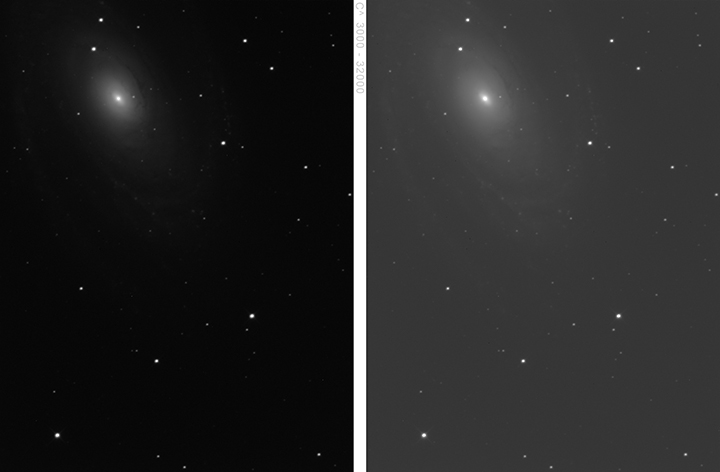
| L-filter |
M81 through two filters
|
Clear filter |
After individual adjustment:
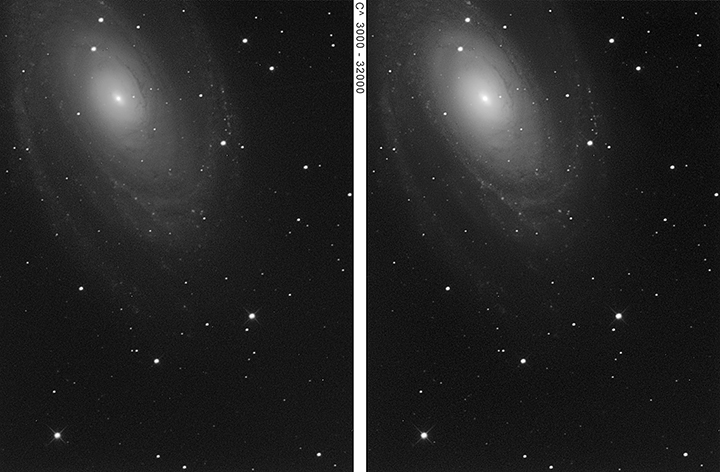
Then the sky fell apart. M51 is through clouds (with no stars visible!). Here's the result of a blind slew followed by two hours of 300s subs without guiding (at least we know that my polar alignment is pretty much on the money):
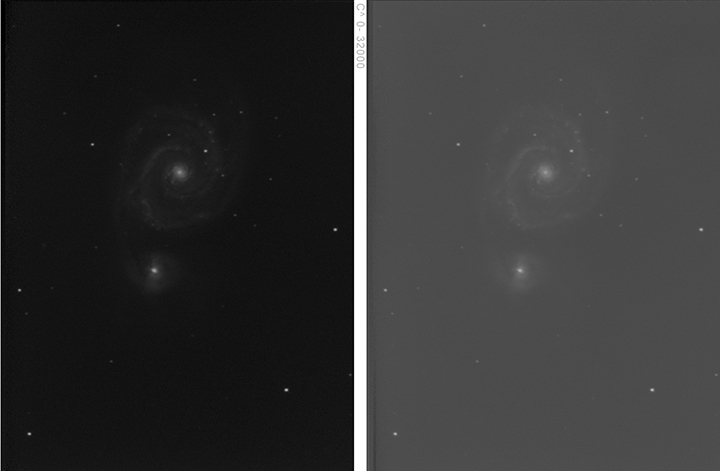
| L-filter |
M51 through two filters
|
Clear filter |
That one's too rough to work more with, but it does demonstrate that the filters behaved the same way on both subjects, unlike the previous night when I must have somehow messed up the filter dialog / setup / preset somewhere in Maxim DL when shooting M81. The preset used for these images works correctly, so clone it into the rest of the drop down exposure items and sin no more.
I'm leaving the flub in the slowblog as a warning to myself and others: watch it!
Here's why I think the C filter should have a real advantage, especially in the very deep sky:
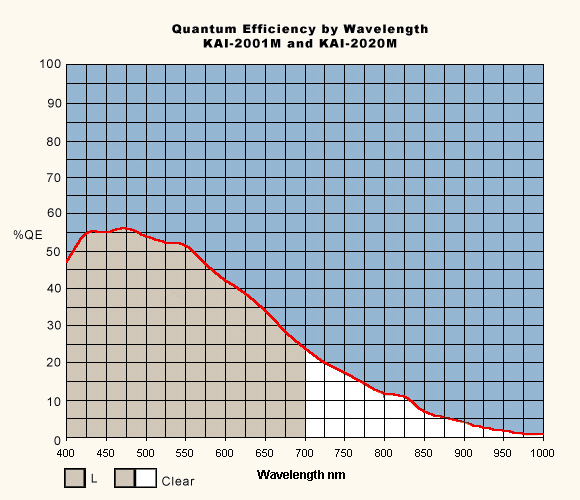
(Modified graphic from SBIG.)
The red line is the spectral response curve of the Kodak CCD sensor in my SBIG ST2000XM. The tan area under the curve represents light collected through the L filter. The sum of the tan and white areas represents light collected through the C filter. By squinting and "graphically integrating" the curve, I see 120 squares in tan and 20 in white. The CCD with the clear filter collects 140/120 = 1.17x as much light as the CCD with the L filter. That should be a measurable, if not always visible, advantage. Out on the edges, it's a real difference. It's not the difference between black and whte, but it is the difference between black and dark grey.
Note that the L filter has consistently returned ever so slightly tighter PSF's (3.34" vs 3.45" FWHM, for example). Keep an eye on that, have CCD Inspector look at a large pile of data. Re-evalute the proper exposure time under bright skies; you're already going a little long at 300s (even when the Moon isn't shining), and with the C filter, you'll be even further out of line. And you might want to pick a filter for the night rather than selecting L or C target by target since it makes sense to match the night's flat to the luminance channel (or make two flats in twilight; that's easy).
And just to show you that I do sometimes plan ahead, my test images of M81 were aimed at opposite ends of the spiral so I could do this: here's the last two sessions' M81 C-filter images combined into a two-frame mosaic.

M81
two panel mosaic
1 hr to the left, 1h5m to the right